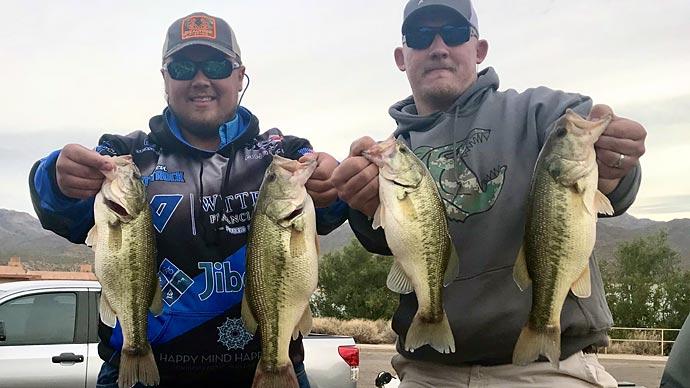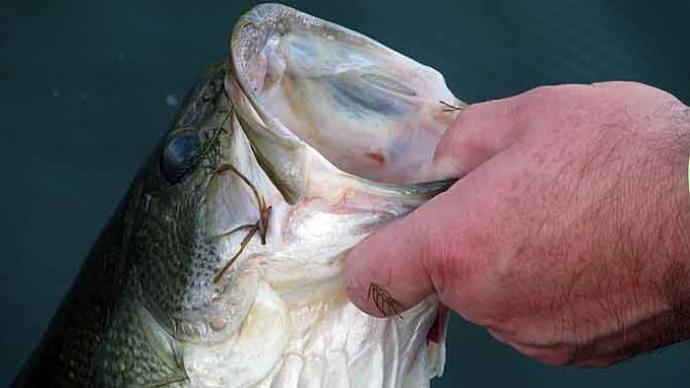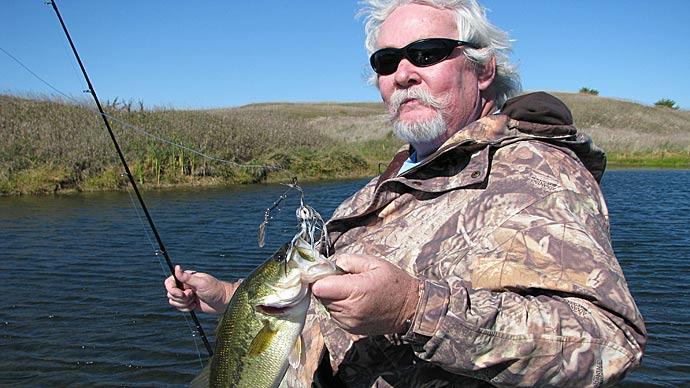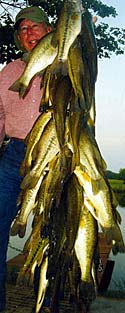
Bass fishing rose to national prominence advocating the principle of "catch and release". The well-intended philosophy was passed down through generations of anglers. But promoters of that noble movement left out one important caveat—"unless you're fishing small ponds".
Weekend after weekend, early fishermen visited their favorite lake. They caught numerous fish and proudly released them. No one thought much about those bass remaining the same size...weekend after weekend. They were having too much fun. Folks assumed the fish eventually would grow on their own.
After all, wasn't it someone's dad who professed, "Throw the little ones back, so they can grow"?
Those were the days before pond owners learned new-fangled terms like food chain management. They thought Nature would provide unlimited minnows, crawfish, frogs, sunfish and other forage. Not true. We also must HARVEST predator species to achieve a balanced fishery whether it's largemouth bass we seek or the most colorful of trout.
Pond management and fisheries consultants emphasize that ponds are confined impoundments. They are stocked and inhabited by highly efficient predators. If the predator population is allowed to outnumber and over-power the food chain, there can be only one unfortunate outcome.
Fish growth levels off, or worse, declines.
As fishermen do, they swap stories at the coffee shop or their favorite digs. One told of seeing bass jumping out of the water chasing dragonflies. His buddies chuckled, dismissed the tale, and awarded him Best Story of the Week.
A couple of weeks later, that fisherman visited the same pond. His earlier observation was not a fluke. Small bass still were chasing dragonflies. He hadn't seen that around other ponds. Why here? He related the experience to other friends and one jokingly replied, "Maybe that's all they had to eat." Little did the gentleman know, he described a common condition. Too many bass. Too little food. The food chain couldn't produce enough forage to feed the masses.
I'll be first to volunteer for handing-out circulars encouraging thoughtful catch and release of large-enough bass. I'll also be first to grab a "bullhorn" and relate the importance of harvest. Close friends say I sound like a preacher when joining a conversation on the subject. I'm expecting one of them to give me a pulpit for a birthday present. I know I'm proverbially preaching to the choir on some management topics. For those of you who recently joined our congregation, many of our elder board will tell you "harvest" is the gospel according to pond managers.
Habitat is the first commandment of successful pond management. After food chain and genetics, I echo wide belief that harvest is the fourth commandment.
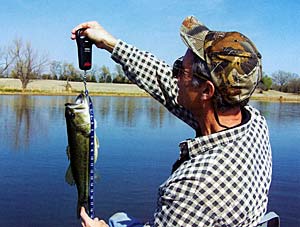
Ask a rancher why he runs 50 head of cattle in one pasture and 150 in another. He'll tell you each animal must eat a scientifically calculated amount of food to gain weight. If the cow doesn't reach weight gain goals, the rancher doesn't make a profit. If he overstocks the pasture, there will be a food shortage. Cattle resort to eating leaves from trees instead of nutritional grasses.
The rancher also sells his calf crop each year to maintain a healthy herd number the pasture can support. Like cattle, fish are in a confined space. Small ponds provide a limited amount of food. We must harvest annual recruitment, like the rancher, so the bass feed trough is always full of plump bluegill.
Remember your kid's slumber parties? You couldn't keep enough food on the kitchen table. Young bass are the same. Think of them as teenagers at the party. They have insatiable appetites. They're in a fast-growth phase.
A marauding school of eight to 12-inch bass can eat a giant hole in a size-class of bluegill. Eight to 12-inch bass eat l- to 3-inch sunfish. Before you realize it, that segment of the forage population is practically extinct for that moment. The bass haven't grown much, but the few surviving bluegill have. Soon, adult bluegill are too large for overcrowded bass to eat. It's a dismal picture for the bass, but occurs fairly often.
The good news is that, most of the time, there are enough adult bluegill to continue the game...the game of reproducing again and again.
One of my favorite facts about bass states they must consume approximately eight to 10-pounds of forage to gain "just one pound". Imagine, it takes about 80 pounds of live forage fish eaten to grow and weigh eight pounds. If your primary sportfish fulfills only 50 percent of that requirement in one or two seasons, it will not reach full growth potential. Have you caught a bass and noticed the head was larger than its body? It should appear just the opposite. Food chain adjustments may get the forage train back on track, but under-developed fish cannot make up for the lost growing season(s) as an end gain.
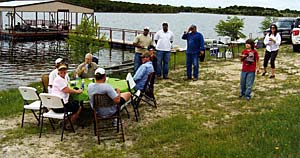
Harvest policies should be determined by goals of your management strategy. Consult a professional biologist. If your goal is trophy bass, harvest fish 16-inches and under, after the fishery is at least three, preferably into four, years old.
Annual harvest should average 20- 25 pounds per surface acre, spread out over an entire growing season. If your goal is a "quantity fishery", higher catch rates per hour, harvest 15 to 20-pounds of bass 14-inches and under, per surface acre.
Since crappie are predators, they should be high on the harvest list. Same for green sunfish, channel catfish, and other species with larger mouths which compete with bass for baitfish.
For other predator fish, such as smallmouth bass and trout species, harvest based on your goals and how well the fish reproduce in your waters. Smallies don't typically recruit in the same fashion as largemouth bass, so understand what they do in your waters. Same goes for different species of cold water fish. Some spawn, some won't. Some can, some can't. Those factors will influence your harvest program.
It's not necessary to harvest your quota by May in any given year. But, sooner is better. With less competition, remaining fish will achieve better growth rates in short growing seasons. Plus, it's better to go into the spring and summer with fewer predators to give your food chain time to replenish over the growing season. Pond owners MUST harvest bass and other predator recruitment. If you take shortcuts or fail to enforce harvest policies, expect disappointing results in your management program over the long haul.
If you're not a big fish eater, find those anglers who can no longer travel to their old fishing hole. Surprise them with a bag of fresh fillets. Install a live box at the pond. Call the landowner or a neighbor and tell them to get the frying pan out and start peeling potatoes, supper's in the box.

If your 10 to 14-inch bass are healthy, contact an area consultant. Some of his customers may need to restock a missing age class or refresh genetics in an older lake. Sell the valuable bass surplus, if possible. Use those funds to buy another feeder and bolster your bluegill base. Hold a fishing tournament with buddies. Enjoy the harvest at a shoreline fish fry. If you have a large quota and too little fishing time, call the consultant. He can expedite harvest with an electrofishing boat. It will cost you a few dollars, but what's your fishery worth?
Does your lake manager recommend harvesting a percentage of adult bluegill? Transfer some to supplement forage in adjacent ponds. Stock 100 to 150 per acre in ponds with mature bass, where needed. Does your lake need more bluegill? Convert a one-quarter acre or smaller pond to a bluegill hatchery. Make sure it does not contain any fish, especially stray bass. Stock it with 25-50 adults in the spring. You'll have thousands of fingerlings by fall. Seine or trap them, move to your primary sport fishing lake, and send bass into a fall feeding frenzy. At the risk of sounding like a broken record, remember above-mentioned food requirements a bass must meet to develop normally.
Regularly sample size-classes of bluegill in your fishery. It's important to see a range of all lengths. Abundant bluegill in all sizes ensures feeding opportunities for bass of all sizes. If you suspect the bluegill base is out of balance, stock tilapia or threadfin shad for a couple of seasons, if regulations in your state allow. Bass will utilize those delicacies. By relieving feeding pressure on bluegill, they can rebuild populations.
Monitor harvest success by consistently sampling relative weights of bass. If your 16-inch bass weighs only two-pounds in the spring, sound the harvest alarm. If 16-inchers tip scales at two-pounds, four-ounces in the fall, congratulations, you've met standards of the American Fisheries Society.
Harvesting requires commitment. If you fish until dark, the last thing you want to do is clean fish when you have a two-hour drive home. I've been there. But some of my most memorable fishing experiences resulted from fulfilling harvest policies.
I got hooked on pond management before Webster's Dictionary recognized the term. I was a new member of a North Texas fishing club with a 50-acre lake. When arriving for my first tournament, the member managing our lake advised we must harvest all bass under 14-inches. He was serious! My initiation later that evening was helping clean more than 100 fish. His "serious enforcement" of harvest and forage policies created some of the best fishing I've experienced anywhere, including Mexico.
I derive great pleasure from implementing management programs that improve quality of life for furry and scaly critters. While pursuing that passion, I've developed a keen awareness of monitoring a pond or pasture's ability to feed its inhabitants. If you have the opportunity to observe lake surveys, you'll soon join the cause. It's disappointing to see the potential of a beautiful pond go untapped.
Everyone's heard of Monday Morning Quarterbacks. I've been an armchair fish and wildlife biologist for many years. Some might call me a "groupie" since I hang on every word from Bob Lusk, Dr. Dave Willis, Dan VanSchaik, and other Pond Boss contributors. I'm not sure how I missed being a biologist. I must have been one in a previous life. Surely, I'll be one in the next.
Next time friends say their fishing trip netted only small ones, share the gospel about harvest. It will improve their pond productivity and angling.
Reprinted with permission from Pond Boss Magazine

